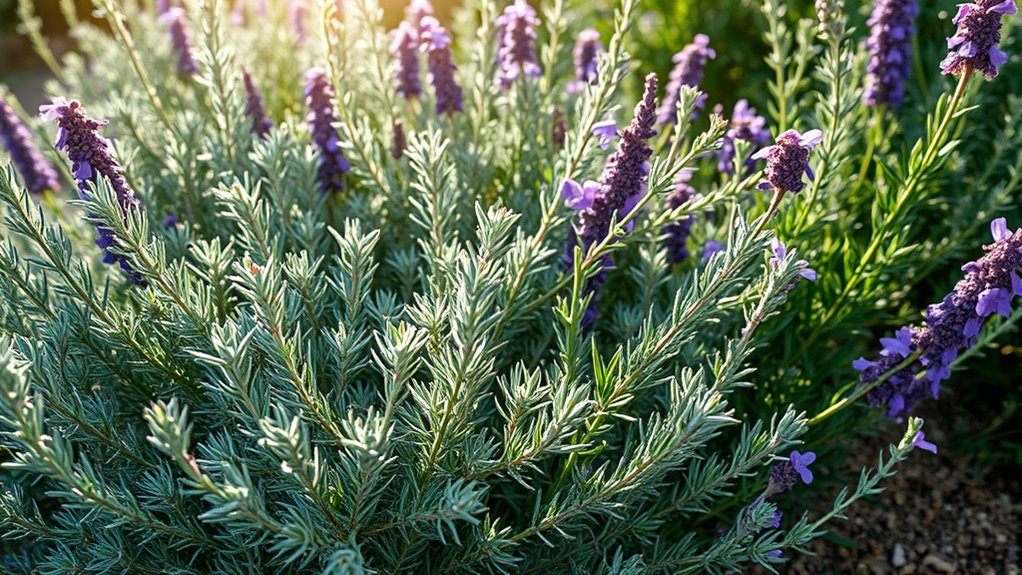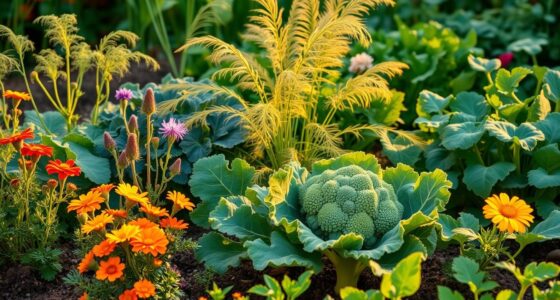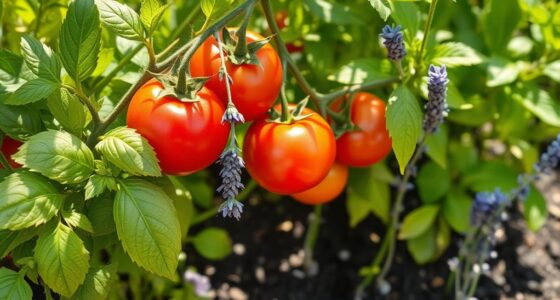The best companion plants for rosemary include fragrant herbs like lavender, chives, and garlic, which repel pests and attract beneficial insects. Flowers like marigolds, daisies, and butterfly bushes also draw pollinators and help keep pests away. Avoid planting rosemary near beans, cabbage, or fennel, as they can hinder its growth. For more tips on creating a healthy, pest-resistant garden, explore further to maximize your herb’s potential.
Key Takeaways
- Plant rosemary near marigolds, lavender, and garlic to naturally repel pests and attract beneficial insects.
- Avoid planting rosemary with beans, cabbage, and fennel, as they inhibit its growth.
- Combine rosemary with flowering plants like daisies and butterfly bush to attract pollinators.
- Use companion herbs such as chives and lemongrass to enhance pest control and support plant health.
- Arrange taller plants behind rosemary to ensure proper sunlight and airflow, promoting healthy growth.
Vegetables That Thrive With Rosemary
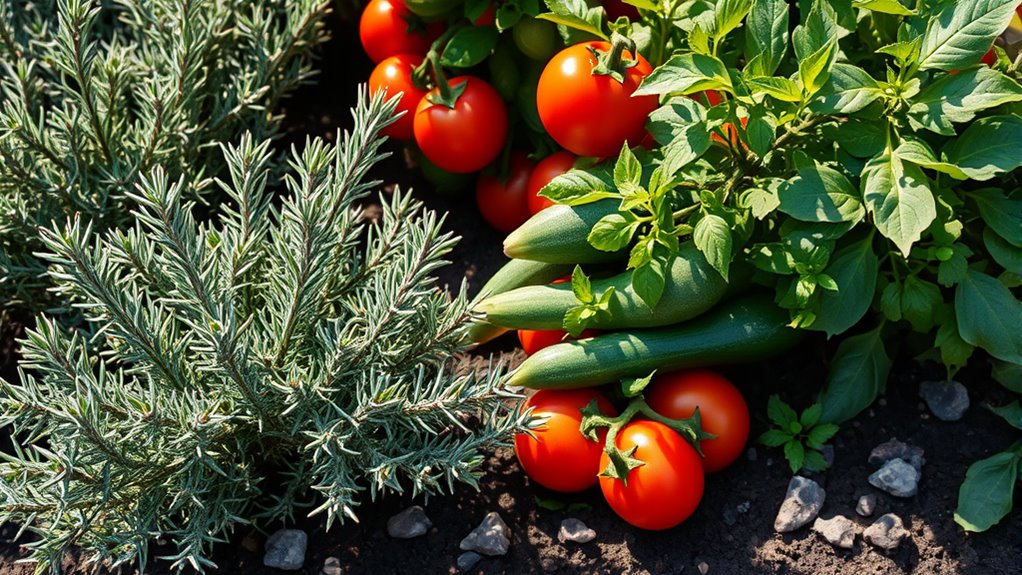
Vegetables that thrive with rosemary often benefit from its natural pest-repellent properties and ability to improve soil health. Carrots, for example, grow well alongside rosemary because they benefit from reduced pests like carrot flies. Beans and peas also do well, as rosemary helps deter aphids and other insects. Additionally, leafy greens such as spinach and lettuce thrive near rosemary because the herb’s aromatic oils can suppress pests without harming these delicate plants. Rosemary’s ability to improve soil drainage and add organic matter creates a healthier environment for root vegetables. Keep in mind that rosemary prefers well-drained soil, so choose vegetables that tolerate similar conditions. The presence of rosemary can also enhance soil fertility by contributing organic matter and supporting beneficial soil microorganisms. Pairing these vegetables with rosemary can boost your garden’s productivity while reducing the need for chemical pest control.
Herbs That Complement Rosemary’s Growth
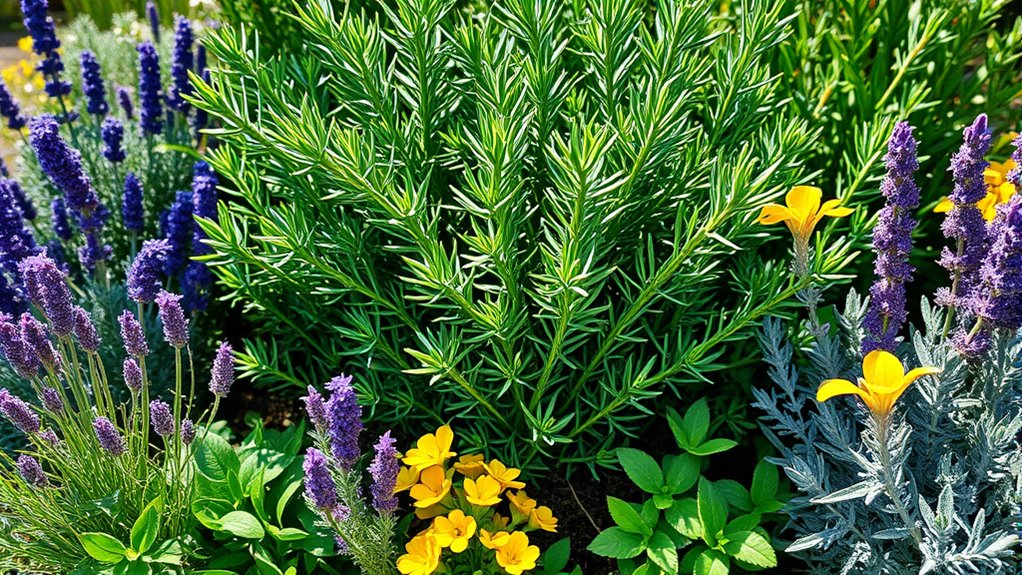
Pairing rosemary with the right herbs can enhance your garden’s health and aroma. When you choose herbs that grow well alongside rosemary, you create a thriving, aromatic environment. These herbs can improve soil health, deter pests, and boost flavor profiles. Here are three top choices:
Pair rosemary with sage, thyme, and oregano for a healthy, aromatic garden.
- Sage – Its hearty leaves complement rosemary’s aroma and thrive in similar conditions. Companion planting can maximize the benefits of growing these herbs together.
- Thyme – A low-growing herb that shares water and sunlight needs, making it an ideal companion.
- Oregano – Its robust growth supports soil health and pairs well in culinary uses.
Plantting these herbs together can create a symbiotic relationship, promoting healthy growth while enhancing your garden’s scent and productivity. Incorporating natural signs can also help you monitor plant health and optimize growing conditions.
Flowers That Attract Beneficial Insects to Rosemary
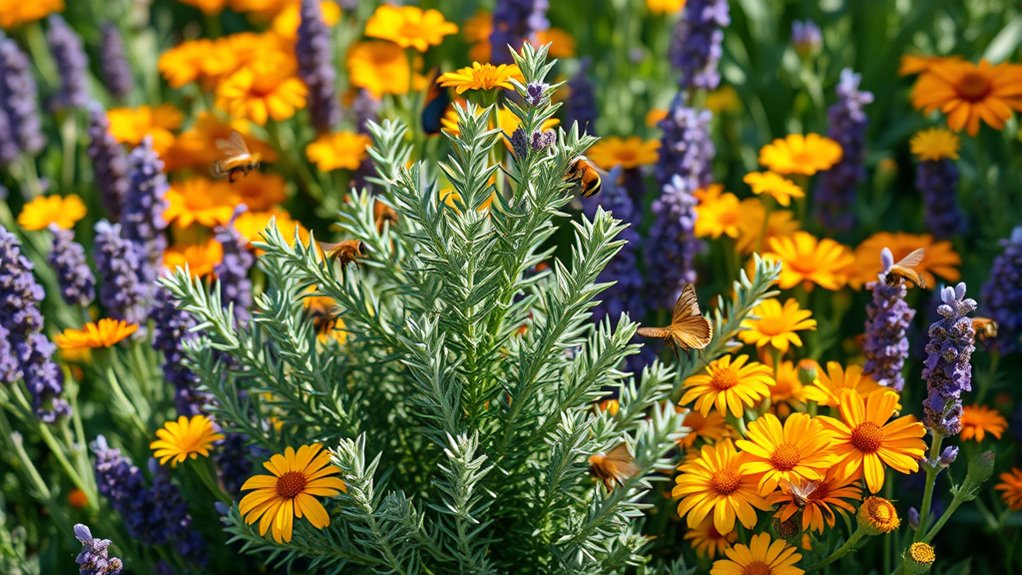
Flowers that attract beneficial insects to rosemary can considerably boost your garden’s health and productivity. By planting blooms like marigolds, daisies, and lavender nearby, you draw in pollinators and predatory insects that naturally control pests. These beneficial insects, such as ladybugs, hoverflies, and parasitic wasps, target common rosemary pests like aphids and spider mites. When you include these flowers, you create an inviting environment that encourages these helpful bugs to settle in your garden. This natural pest control reduces the need for chemical treatments and promotes healthier rosemary growth. Choose colorful, nectar-rich flowers to maximize attraction. Regularly flowering plants ensure a continuous supply of nectar and pollen, keeping beneficial insects active and engaged with your rosemary plants throughout the growing season. Additionally, incorporating flowering plants that provide abundant nectar can further enhance the presence of beneficial insects and support a thriving garden ecosystem. Incorporating native plants can also be beneficial, as they are more likely to attract local beneficial insects. To further optimize your garden’s health, consider plant diversity, which can attract a wider range of beneficial species and improve overall pest management.
Shrubs and Bushes as Rosemary Neighbors
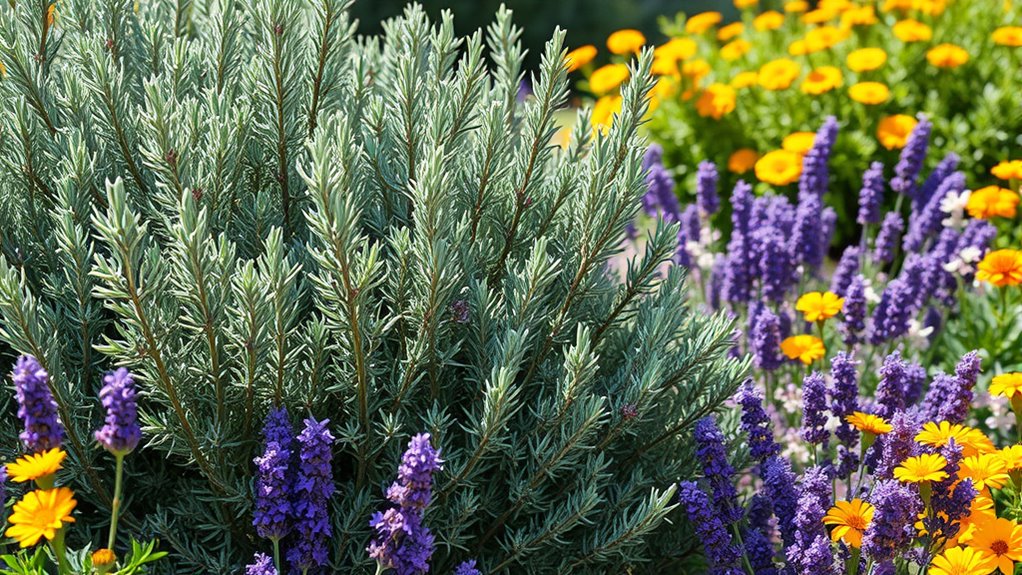
Planting shrubs and bushes near your rosemary can enhance its growth and protect it from pests. Look for species with complementary blooms that attract beneficial insects or act as natural pest repellents. Choosing the right neighbors creates a healthier, more balanced garden environment. Incorporating best companion plants can further support your rosemary’s health and vitality. Additionally, selecting plants that promote ecosystem balance helps maintain a sustainable garden. Using plants with mutual benefits can improve soil health and attract pollinators, contributing to a more thriving garden ecosystem. Considering plants that assist in pest control can additionally reduce the need for chemical interventions. Incorporating pollinator-friendly plants can also boost pollination and overall plant health in your garden.
Complementary Blooming Plants
Because rosemary blooms in late spring to early summer, choosing complementary shrubs and bushes that bloom at different times can extend visual interest and attract pollinators throughout the growing season. Incorporate plants that flower earlier or later to create a continuous display. For example, planting lavender, which blooms in early summer, complements rosemary’s peak. Consider adding butterfly bush, which blooms in late summer, to keep your garden lively. Additionally, hydrangeas bloom from mid-summer to fall, providing ongoing color. These choices not only enhance your garden’s beauty but also support pollinators year-round. By selecting shrubs with overlapping or sequential blooming periods, you ensure your garden remains vibrant, inviting, and beneficial to local wildlife. Creating a pollinator-friendly environment can further boost biodiversity and help sustain the ecosystem services that support your garden. Utilizing blooming plant cycles effectively can maximize pollinator attraction and extend garden interest. Understanding plant blooming patterns can help you design a more sustainable and attractive garden, especially when considering seasonal flowering schedules to optimize pollinator visits.
Pest-Repelling Shrubs
Integrating pest-repelling shrubs around your rosemary can create a natural defense system that deters common pests. Shrubs like lavender, sage, and rosemary itself emit strong scents that confuse or repel insects such as aphids, whiteflies, and spider mites. These plants release essential oils that disrupt pests’ sense of smell, making it harder for them to locate rosemary or other nearby plants. By planting these shrubs strategically, you reduce the need for chemical pesticides and promote a healthier garden ecosystem. Additionally, pest-repelling shrubs often attract beneficial insects like ladybugs and predatory wasps, which help keep pest populations in check. Employing integrated pest management strategies can further enhance your garden’s resilience against pests. Understanding the benefits of companion planting can help you optimize your pest control efforts. Incorporating diverse plant species also helps improve biodiversity, leading to a more balanced garden environment. Employing positive energy and mindful plant arrangements can also foster a more balanced and thriving garden environment. Overall, incorporating these resilient bushes not only protects your rosemary but also enhances your garden’s biodiversity. Recognizing the importance of natural pest control helps gardeners create sustainable and eco-friendly gardens.
Vegetables to Avoid Planting Near Rosemary
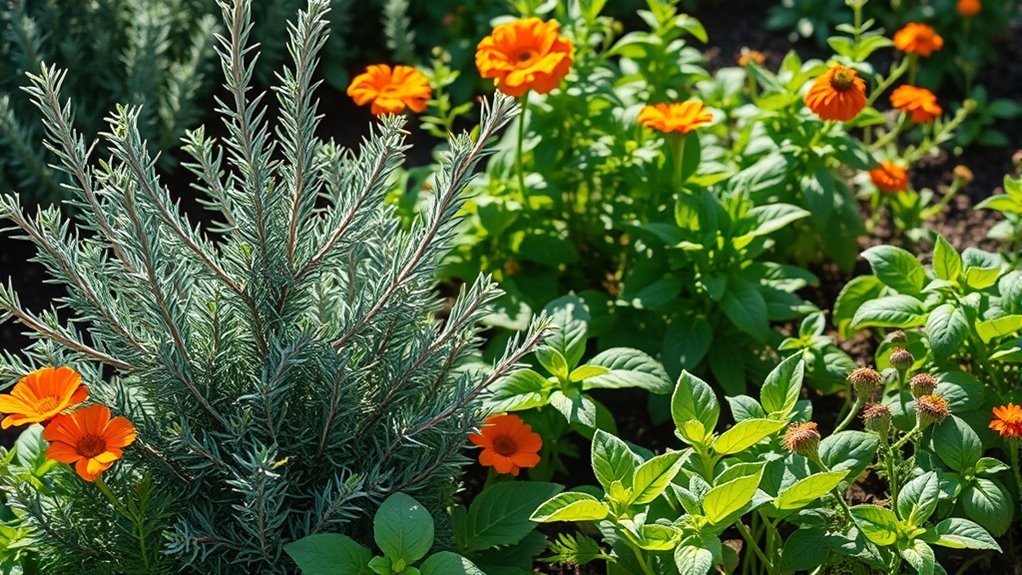
Certain vegetables don’t thrive when grown near rosemary, as the plants can compete for nutrients or release substances that inhibit each other’s growth. To guarantee healthy development, avoid planting these vegetables close to rosemary:
- Beans – They can compete for nitrogen, reducing rosemary’s growth.
- Cabbage family (e.g., broccoli, cauliflower) – These vegetables may release compounds that hinder rosemary’s vigor.
- Fennel – It’s known to inhibit the growth of many herbs, including rosemary, due to its allelopathic properties.
- Proximity to other plants can also influence plant interactions, so careful planning is essential for a thriving herb garden. Additionally, understanding plant compatibility can help you optimize your garden layout for healthier plants. Being aware of plant growth habits can prevent unintended competition and promote a balanced garden environment.
Companion Plants for Pest Control and Disease Prevention

Pairing rosemary with specific plants can help you naturally ward off pests and prevent diseases, reducing the need for chemical treatments. Marigolds are excellent companions because their strong scent deters aphids, nematodes, and whiteflies. Lemongrass also works well, as its aromatic oils repel mosquitoes and other insects. Lavender complements rosemary by confusing pests and attracting beneficial insects like pollinators and predatory bugs that keep pest populations in check. Chives and garlic release sulfur compounds that repel aphids, spider mites, and other common pests. Additionally, planting nasturtiums nearby can act as a trap crop, drawing pests away from rosemary. These companion plants create a natural pest-resistant environment, promoting healthier plants and reducing the risk of disease transmission caused by insect-borne pathogens. Incorporating effective companion planting techniques can further enhance your garden’s resilience against pests. Using integrated pest management strategies can optimize pest control while maintaining ecological balance.
Tips for Arranging Your Rosemary Companion Planting Layout

To maximize the benefits of your rosemary companion planting, it’s essential to plan your layout thoughtfully. Proper arrangement ensures ideal growth and pest control. First, place rosemary where it receives full sun, as this boosts its aroma and health. Second, keep taller companions, like lavender or sage, slightly behind or around rosemary to avoid shading. Third, group plants with similar watering needs together to prevent over- or under-watering. Consider spacing carefully—allow at least 12-18 inches between plants—to promote airflow and reduce disease risk. Use raised beds or containers if space is limited, making it easier to control soil conditions and placement. Thoughtful planning helps your garden thrive, making your rosemary and its companions more effective and easier to care for.
Frequently Asked Questions
Can Rosemary Be Grown Successfully Indoors With Companion Plants?
You can definitely grow rosemary successfully indoors with companion plants. Choose plants that thrive in similar conditions—well-draining soil, plenty of sunlight, and moderate watering. Herbs like thyme or oregano work well, as do low-maintenance succulents. Keep your rosemary near a sunny window and guarantee proper airflow. Combining compatible plants not only saves space but also creates a healthy, thriving indoor garden environment.
How Do Soil Conditions Affect Rosemary’S Companion Planting Choices?
Imagine your garden’s future depends on one essential detail—soil conditions. They can make or break your rosemary’s growth and its companions. When soil is well-draining and slightly alkaline, you reveal the secret to thriving plants side by side. But if it’s too wet or acidic, even the best companions struggle. Pay close attention to your soil, and you’ll create a harmonious environment where rosemary and its friends flourish together.
Are There Specific Watering Needs for Rosemary When Planted With Certain Companions?
When planting rosemary with certain companions, you should consider their watering needs to guarantee both thrive. Rosemary prefers well-drained soil and moderate watering, so avoid overwatering companions that also dislike excess moisture. If your companions need more water, adjust your watering schedule accordingly. By matching their needs, you prevent root rot and promote healthy growth, creating a balanced environment that benefits all your plants.
What Is the Ideal Spacing for Rosemary and Its Companion Plants?
A stitch in time saves nine, and proper spacing prevents future headaches. When planting rosemary with its companions, give each plant about 18 to 24 inches of space to guarantee good air circulation and healthy growth. This spacing allows sunlight to reach all plants, reduces diseases, and makes maintenance easier. Keep in mind, closer planting can lead to competition, so give each plant room to thrive and flourish.
How Do Different Climate Zones Influence Rosemary’S Companion Planting Options?
Different climate zones substantially impact your companion planting choices for rosemary. In warmer zones, you can pair it with drought-tolerant plants like lavender or sage, which thrive in similar conditions. In cooler zones, choose hardy companions like thyme or marjoram that can withstand colder temperatures. Understanding your zone helps you select plants that will grow well together, ensuring a healthy, thriving garden.
Conclusion
By choosing the right companions for your rosemary, you’ll create a thriving, harmonious garden. Mix in herbs, flowers, and vegetables that support its growth while warding off pests—think of it as your very own secret garden of Eden. Just like a skilled alchemist, arrange your plants thoughtfully, and you’ll enjoy a bountiful, pest-resistant herb patch. With a little planning, your rosemary garden will flourish, proving that good neighbors truly make all the difference.
